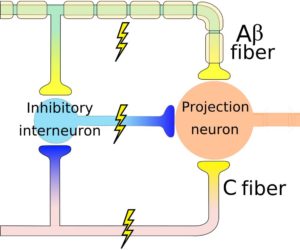Mechanism of Pain
Gate Control Theory is a theory that was proposed by R. Melzack and P. D. Wall in 1965, explaining how the mechanism of pain occurs.
According to this theory, pain impulses reach the dorsal horn of the spinal cord with two types of nerve fibers; large diameter fibers (Aβ fiber) and small diameter fibers (C fiber). Large-diameter fibers transmit feelings such as touch, vibration, pressure, while small diameter fibers transmit harmful feelings such as pain. Both fibers affect T cells. When the cells are stimulated at a certain level, we begin to feel pain. Inhibitor cells regulate whether the door is open or not. Small diameter fibers stimulate T cells when activated by an event such as pinning. This opens the pain door, causing the pain signal to be transmitted to the thalamus. However, at the same time, the feeling of pain is reduced when inhibitor cells are stimulated by large diameter fibers through a distractive event such as rubbing, caressing, or vibration.



